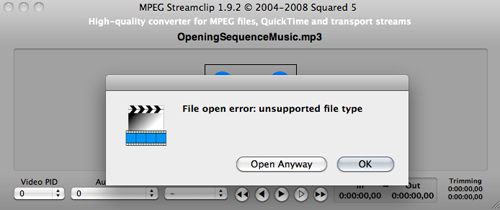

- #Best settings fro mpeg streamclip for final cut pro full
- #Best settings fro mpeg streamclip for final cut pro pro
So – there you have it – we give you the pixels in the purest representation as captured – what you do with them from there is up to you. We’ve also done some benchmarking on the final stage of encoding for distribution – we’re happy that we can produce the best looking results, faster than any other solution – but I’d encourage you to test in your pipeline and let Adobe know if this is not the case for you. QuickTime and get into the details – you’ll see some differences, particularly in transitions between bright and dark areas and color edges the net – you end up with a higher quality image by getting the pixels natively. If you test the approach that Adobe and Rarevision use vs. We’re not alone in our findings – we found some other folks who apply the same philosophy as Adobe, Rarevision has a stand-alone tool that follows the same processing as the Adobe Pipeline – you can see some of their findings on their website ( ). However we found that if you introduce grain at the front end of the decode chain you end up with a more appealing image in these cases, however, any noise introduced reduces picture quality – not always noticeable when you’re looking at a small 320×240 image on a web site, but may be of concern for a high resolution workflow. We do the later and this is the root of what is different in the results out of our respective products.Īs we’re dealing with an image that has been scaled and compressed, our philosophy is to preserve every bit of color, light and detail we can – so we apply no filtering, as such, when you do this with some images where the there are broad areas of the image have gradations of similar color – and you apply no filtering, you get the results we saw on this thread.
#Best settings fro mpeg streamclip for final cut pro full
On a Mac, you can lean on QuickTime to do this – or go get the pixels yourself and have full control. There is a lot in that statement as I know as we’re talking about Color Space conversion from YCbCr to RGB as well as decompression.

Well – our team has gone back and done the homework and we can now say categorically that we are correctly reading every pixel as it is captured and presenting it without alteration. Wanted to follow up on my note from December on this topic. I’ll finish off by reinforcing the fact that I’m very new to Premiere Pro, this could very well be due to user error on my part so if there’s something obvious I’m missing or any other tip you can give please don’t hesitate to leave a comment.īill from Adobe here again. That being said this makes it a great real world test as after all these cameras don’t shoot perfect footage so we have to deal with the nasty h.264 codec thats being produced one way or another. What is the magic setting to export from premiere and retain that quality?Īs I stated at the start of this post the original footage from the 5D was far from perfect, it already contained compression artefacts and as such does not make for a perfect test. I spent many hours testing lots of different export options, codecs and formats as well as playing with options in the preferences, I still couldn’t export a file that matched or exceeded the image quality in the file exported from FCP. It seems that even though the footage within Premiere itself is holding up really well it’s degrading more upon export than my FCP workflow.
#Best settings fro mpeg streamclip for final cut pro pro
Throughout this post you need to have your browser full screen and click on the images to see the detail, the small ones below don’t really show much difference.ġ280×720 H.264 Encode 5000Kbps from Premiere Pro Lets see how the two workflows deal with it… The H.264 codec in the 5D struggled with this and the source footage contains some macro blocking, but nothing too terrible. This was a particularly tricky shot for the codec as the background contains shaded solids caused by a natural vignette from my 70-200 lens. The file has a runtime of 4:41 and in it’s original state is 1.5GB. Firstly let me describe the workflow involved in each process.įor both workflows I used the same H.264 mov file from an interview I shot recently on the Canon 5D mark II.

Browsing the web reading various reports and reviews about Premiere Pro I keep coming across the statement that because Premiere Pro works without the need to transcode H.264 DSLR files the footage inherently retains more quality.Īfter using Premiere Pro for a week or so I decided to spend some time investigating this theory and came up with some interesting results that I thought I’d share with you.


 0 kommentar(er)
0 kommentar(er)
